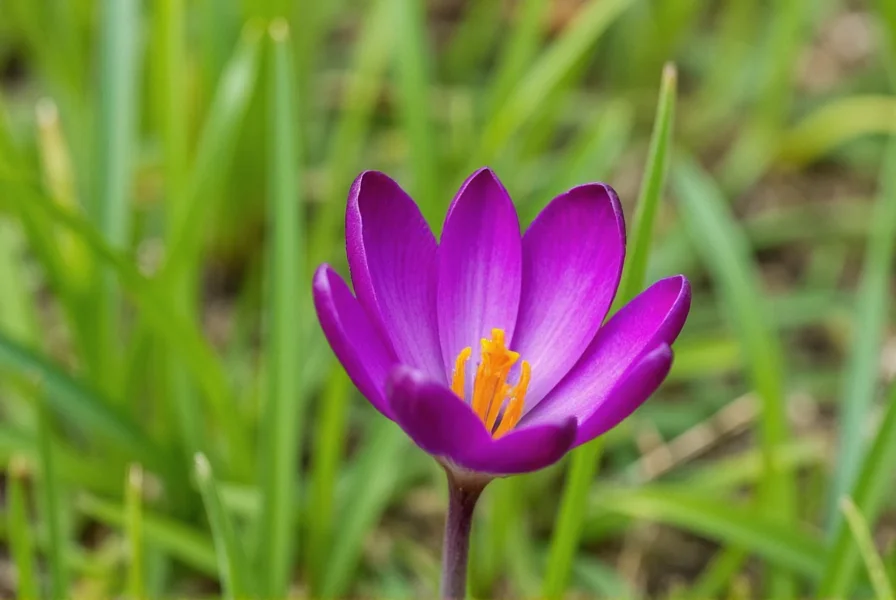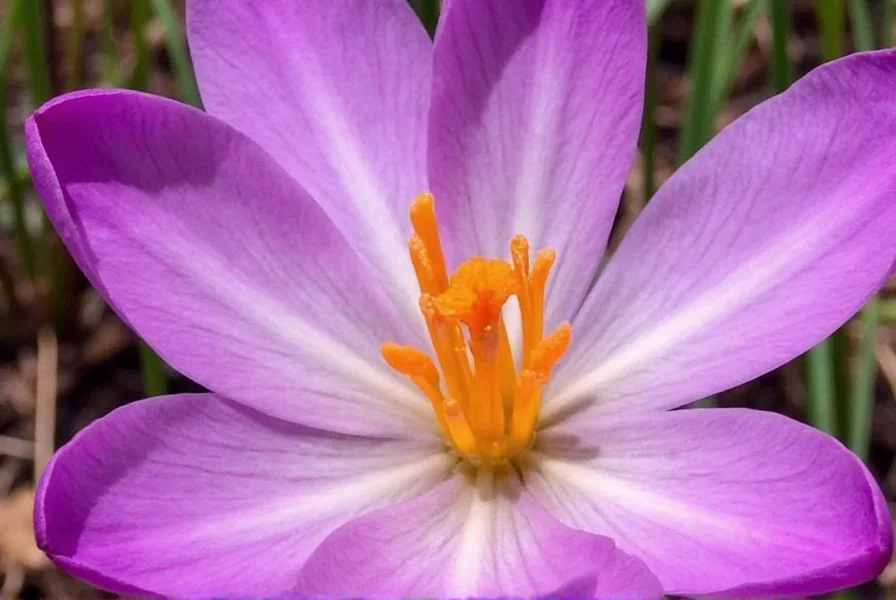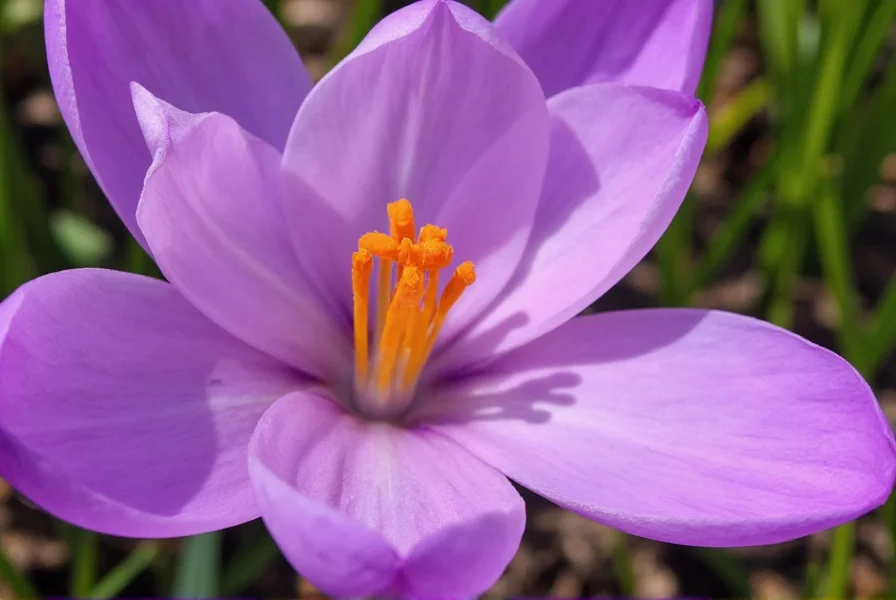The Crocus sativus, commonly known as the saffron crocus, belongs to the Iridaceae family and is the sole source of genuine saffron spice. Unlike many commercial crops, this autumn-blooming perennial produces its valuable saffron threads not from seeds or fruit, but from the vivid crimson stigmas within each delicate purple flower.

Botanical Characteristics of the Saffron Flower
The saffron crocus grows from corms (underground storage organs similar to bulbs) and reaches heights of 15-25 cm when in bloom. Each flower features:
- Three vivid purple petals arranged symmetrically
- Three bright yellow stamens surrounding the central stigma
- Three deep red stigmas that extend beyond the flower's center
- No fragrance, distinguishing it from many other crocus varieties
What makes Crocus sativus unique among flowering plants is that it's completely sterile—it cannot reproduce through seeds and must be propagated manually by dividing corms. This biological limitation contributes significantly to saffron's high cost and limited production.
The Saffron Harvesting Process
Harvesting saffron represents one of agriculture's most labor-intensive processes:
| Harvesting Stage | Time Required | Key Details |
|---|---|---|
| Flower Blooming | One morning only | Flowers open at dawn and wilt by midday |
| Hand-Picking | Approx. 400 flowers/hour | Workers must collect flowers before petals unfurl |
| Stigma Extraction | 150,000 flowers = 1kg saffron | Three stigmas per flower, removed with precision |
| Drying Process | 12-24 hours | Low-temperature drying preserves flavor compounds |
During harvest season (typically October-November), workers must pick flowers early each morning before the sun causes them to wilt. Each flower gets carefully opened by hand to extract the three precious red stigmas without damaging them. This meticulous process explains why saffron commands prices between $3,000-$15,000 per kilogram, making it more valuable than gold by weight.
Geographical Distribution and Cultivation Requirements
The saffron crocus thrives in specific Mediterranean and Middle Eastern climates with:
- Dry summers followed by wet springs
- Cold winters that trigger flowering
- Well-drained, calcareous soils
- Full sun exposure
Iran produces approximately 90% of the world's saffron, followed by smaller operations in Spain, India (Kashmir), Greece, and Morocco. Attempts to cultivate saffron outside these traditional regions often fail due to the plant's specific climatic requirements. The flower for saffron production cannot tolerate excessive moisture or extreme temperature fluctuations during its growing season.
Common Misconceptions About Saffron Flowers
Several misunderstandings persist about the flower that produces saffron:
- Myth: Saffron comes from a type of lily or tulip
Fact: Saffron exclusively comes from Crocus sativus, which belongs to a different botanical family than lilies or tulips - Myth: The entire flower is used to make saffron
Fact: Only the three red stigmas (female reproductive parts) are harvested - Myth: Saffron flowers bloom year-round
Fact: Each plant produces flowers for only 1-2 weeks annually during autumn
Understanding what flower produces saffron helps consumers identify authentic products. Be wary of unusually cheap saffron, as genuine saffron's labor-intensive harvesting process makes low-cost products suspicious. The distinctive thread-like appearance, deep red color with orange tips, and hay-like aroma with subtle bitterness characterize authentic saffron threads.
Why This Specific Flower Produces Valuable Saffron
The economic value of Crocus sativus stems from three key compounds found in its stigmas:
- Crocin - The carotenoid responsible for saffron's intense golden color
- Picrocrocin - Creates saffron's distinctive bitter taste
- Safranal - Provides the characteristic hay-like aroma
No other plant contains this precise combination of compounds in concentrations sufficient to produce saffron's unique sensory profile. While some plants like Carthamus tinctorius (safflower) share similar coloring properties, they lack saffron's complex flavor chemistry. This biological uniqueness explains why the saffron crocus flower remains irreplaceable despite centuries of agricultural advancement.

Practical Considerations for Saffron Flower Cultivation
For those interested in understanding saffron crocus cultivation requirements, several factors prove essential:
- Corm Planting: Plant corms 15 cm deep in late summer for autumn blooming
- Water Management: Requires dry periods between waterings to prevent corm rot
- Soil Requirements: Prefers alkaline, well-drained soils with moderate fertility
- Climate Needs: Requires hot, dry summers and cold winters to trigger flowering
- Yield Expectations: Mature plants produce 1-3 flowers per corm annually
Successful saffron flower identification in the field requires recognizing the distinctive purple blooms appearing in autumn when most other crocus varieties remain dormant. The flower for saffron production stands out with its deep purple petals, lack of fragrance, and prominent red stigmas visible even before full bloom.
Frequently Asked Questions
What specific flower produces saffron?
Saffron comes exclusively from the Crocus sativus flower, a sterile autumn-blooming crocus variety. The spice is derived from the flower's three red stigmas, which must be hand-harvested and dried. No other plant species produces genuine saffron.
Why is saffron so expensive compared to other spices?
Saffron's high cost stems from its extremely labor-intensive harvesting process. Each Crocus sativus flower yields only three stigmas, requiring approximately 150,000 flowers to produce one kilogram of dried saffron. The flowers must be hand-picked at dawn and the stigmas extracted by hand before they wilt, all within a narrow 1-2 week harvest window each autumn.
Can you grow saffron crocus in a home garden?
Yes, you can grow Crocus sativus in a home garden if you live in a suitable climate (Mediterranean or similar with hot dry summers and cold winters). Plant corms 15 cm deep in well-drained soil in late summer. Each corm produces 1-3 flowers in autumn, but expect minimal harvests - it takes about 50 home-grown flowers to yield just 1 gram of saffron threads.
How can you identify genuine saffron flowers?
True saffron flowers (Crocus sativus) feature three purple petals, three yellow stamens, and three vivid red stigmas that extend beyond the flower center. They bloom in autumn (not spring like most crocuses), have no fragrance, and grow 15-25 cm tall. The flowers open at dawn and must be harvested the same morning before they wilt.
What makes saffron different from similar spices like safflower?
While safflower (Carthamus tinctorius) produces a yellow coloring similar to saffron, it lacks saffron's distinctive flavor compounds. Genuine saffron contains crocin (for color), picrocrocin (for bitter taste), and safranal (for aroma) - a unique combination found only in Crocus sativus stigmas. Saffron has a complex hay-like aroma with subtle bitterness, while safflower offers only coloring properties.











 浙公网安备
33010002000092号
浙公网安备
33010002000092号 浙B2-20120091-4
浙B2-20120091-4